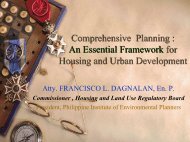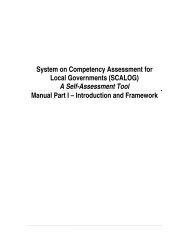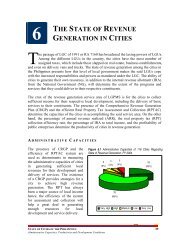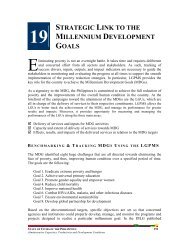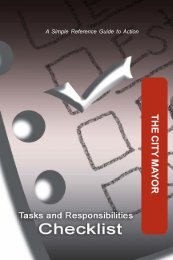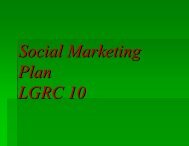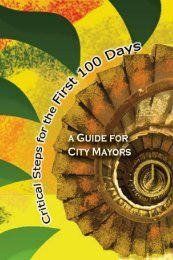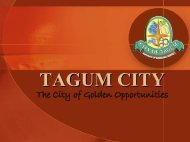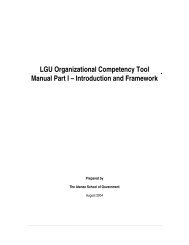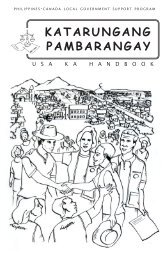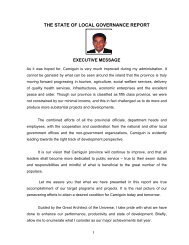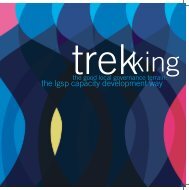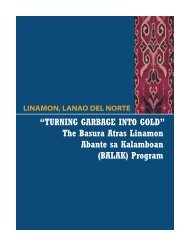Sigma 2005 - LGRC DILG 10
Sigma 2005 - LGRC DILG 10
Sigma 2005 - LGRC DILG 10
Create successful ePaper yourself
Turn your PDF publications into a flip-book with our unique Google optimized e-Paper software.
<strong>Sigma</strong>,<br />
Capiz<br />
Kasama Ka!:<br />
Multistakeholder<br />
Partnerships for<br />
Solid Waste Management
Kasama Ka!: Multistakeholder Partnerships for Solid Waste Management<br />
Copyright © <strong>2005</strong> Philippines-Canada Local Government Support Program<br />
(LGSP)<br />
The Philippines-Canada Local Government Support Program encourages the<br />
use, translation, adaptation and copying of this material for non-commercial<br />
use, with appropriate credit given to LGSP.<br />
Although reasonable care has been taken in the preparation of this book,<br />
neither the publisher and/or contributor and/or editor can accept any liability<br />
for any consequence arising from the use thereof or from any information<br />
contained herein.<br />
Printed and bound in Manila, Philippines<br />
Published by:<br />
Philippines-Canada Local Government Support Program<br />
Unit 1507 Jollibee Plaza<br />
Emerald Ave., Pasig City<br />
1600 Philippines<br />
Tel. Nos. (632) 637-3511 to 13<br />
www.lgsp.org.ph<br />
This project was undertaken with the financial support of the Government of<br />
Canada provided through the Canadian International Development Agency<br />
(CIDA).
Kasama Ka!: Multistakeholder Partnerships for Solid Waste Management<br />
SIGMA, CAPIZ<br />
Philippines-Canada Local Government Support Program (LGSP)<br />
Documentation of LGU Exemplary Practices<br />
Replicable Practice<br />
KASAMA KA!: MULTISTAKEHOLDER PARTNERSHIPS<br />
FOR SOLID WASTE MANAGEMENT<br />
IN SIGMA, CAPIZ<br />
(4 TH CLASS MUNICIPALITY)<br />
CONTENTS<br />
Summary 2<br />
Project Description: Confronting a growing solid waste<br />
problem<br />
2<br />
History: How the project came about 4<br />
Results: Gains from the project 5<br />
Key Implementation Steps 6<br />
Analysis and Lessons Learned 15<br />
Annexes:<br />
Annex A - Executive Order No. 05-S-2003<br />
Annex B - Memorandum of Agreement between LGU and<br />
<strong>Sigma</strong>hanon Development Foundation, Inc (SDFI)<br />
Annex C - Management Structure and Functional Chart<br />
Annex D - KASAMA KA! Solid Waste Management Flyer<br />
October <strong>2005</strong> 1
Kasama Ka!: Multistakeholder Partnerships for Solid Waste Management<br />
SIGMA, CAPIZ<br />
SUMMARY<br />
“Kabalikat sa Maunlad na Kalikasan” or KASAMA KA! is an award-winning<br />
ecological solid waste management (ESWM) program being implemented by the<br />
municipal government of <strong>Sigma</strong>, Capiz, in partnership with the <strong>Sigma</strong>hanon<br />
Development Foundation, Inc. (SDFI), a non-government organization and other<br />
stakeholders.<br />
Piloted in the municipality’s poblacion consisting of its two biggest urban<br />
barangays, Poblacion Norte and Poblacion Sur, the program has successfully<br />
reduced the volume of solid waste in these pilot barangays by more than 50%,<br />
and has improved <strong>Sigma</strong>’s ranking in the annual nationwide Clean and Green<br />
contest.<br />
KASAMA KA features four major components, or the 4E’s: Education,<br />
Engineering, Enforcement, and Entrepreneurship. These components are<br />
focused on ensuring participation through education, technological innovation<br />
at the household level up, strict enforcement of policies, long term planning<br />
and providing livelihood opportunities through recycling and composting<br />
wastes.<br />
After one and half years of implementation, <strong>Sigma</strong>’s ESWM program has been<br />
recognized by the Sangguniang Panlalawigan of Capiz, which issued a directive<br />
to have <strong>Sigma</strong>’s ESWM materials disseminated to all municipalities of the<br />
province for their guidance, information and appropriate action (February<br />
2002). The Philippines-Canada Local Government Support Program (LGSP)<br />
designated the <strong>Sigma</strong> SWM practice as one of five LGSP Learning Resource<br />
Centers in Region VI.<br />
Project Description: Confronting a growing solid waste problem<br />
The Municipality of <strong>Sigma</strong> is a 4 th class municipality with a population under<br />
30,000 located in the central plains of Capiz province. Located at the<br />
intersection of main routes in Panay Island, <strong>Sigma</strong> serves as a transit point to<br />
busy destinations like Boracay, Iloilo City and Roxas City. Its geographic<br />
location has led to <strong>Sigma</strong>’s rapid urbanization which has resulted, in turn, to a<br />
rapid increase in its solid waste generation. In 2001, the daily volume of<br />
<strong>Sigma</strong>’s collected garbage was approximately 8 cubic meters (cu. m.) on<br />
regular days and as much as <strong>10</strong> cu. m. on market days (Wednesdays and<br />
Saturdays). This translated to about 2.8 tons of garbage a week.<br />
Before the project was implemented, there was no effective, municipal-wide<br />
SWM program in <strong>Sigma</strong>. Approximately 68% of households burned their garbage,<br />
16% buried it in their backyards and 11.8% recycled. Only 2 urban barangays or<br />
October <strong>2005</strong> 2
Kasama Ka!: Multistakeholder Partnerships for Solid Waste Management<br />
SIGMA, CAPIZ<br />
3.3% of total households in <strong>Sigma</strong> were served by the ’hakot-tambak’ (collect<br />
and dump) system of the LGU. The ‘hakot-tambak’ consisted of one dump truck<br />
collecting waste from public garbage bins along the roads and certain centers<br />
(market, schools, municipal hall) and unloading it in an open dumpsite some<br />
4.5 km. from the poblacion. When the garbage overflowed from the dump site,<br />
it was either burned or pushed down<br />
the hill towards the river.<br />
Basic Profile: <strong>Sigma</strong>, Capiz<br />
Over time, however, this method<br />
proved hazardous to the health of the<br />
people and the ecological condition of<br />
the municipality. Due to siltation and<br />
clogging from dumped waste, the<br />
Mambusao River -- which cuts across<br />
four big towns of Capiz, including<br />
<strong>Sigma</strong> – was frequently overflowing,<br />
causing increasingly serious flooding<br />
that wreaked havoc on life and<br />
property. As a result, 13 of <strong>Sigma</strong>’s 21<br />
barangays were perennially flooded. In<br />
Location: one of 16 municipalities in Capiz province,<br />
part of 2 nd congressional district; 30 minutes from<br />
the provincial capital of Roxas city; transit point to<br />
Iloilo city, Roxas city, Kalibo and Boracay, Aklan.<br />
Land Area: <strong>10</strong>,170 hectares<br />
Population: 27366 (5541 HH)<br />
Population growth: 2.0 %<br />
Ave. HH size: 4.9 members<br />
Income class: 4 th class<br />
IRA: Php 25.54M<br />
Local Revenues: Php 2.004 M<br />
No. of barangays: 21<br />
Land use: 92% agricultural land, 2,32% forestland,<br />
1.09 built up area<br />
Major industries/economic activities: agriculture<br />
(rice, sugarcane, bamboo, banana, root crops and<br />
other products<br />
2001 and 2002, for instance, almost all households in 13 barangays were<br />
submerged in floodwater, resulting in several deaths and millions of pesos<br />
worth of damage to crops and houses.<br />
In turn, the situation hindered <strong>Sigma</strong> from achieving its goals of having a<br />
vibrant agro-industrial economy and becoming the Center of Education in<br />
Capiz’ second Congressional district and a convenient tourist transit point to<br />
Boracay and Iloilo City.<br />
Project Goals and Objectives<br />
This was the situation that the<br />
KASAMA KA! Ecological Solid Waste<br />
Management program aimed to<br />
address by enhancing ecological<br />
balance in the municipality through<br />
sustainable and integrated waste<br />
management. KASAMA KA!’s goals<br />
were: 1) a clean and productive<br />
environment that will help ensure the<br />
needs of the next generation of<br />
<strong>Sigma</strong>hanons and 2) a clean, healthy<br />
and orderly environment through<br />
waste segregation and recycling<br />
October <strong>2005</strong> 3
Specifically, KASAMA KA aims to:<br />
Kasama Ka!: Multistakeholder Partnerships for Solid Waste Management<br />
SIGMA, CAPIZ<br />
1. Promote the conversion of biodegradable waste into soil conditioner and<br />
the non-biodegradable waste into usable crafts<br />
2. Promote organic farming practices by making available good quality<br />
fertilizer/conditioner at lower cost<br />
3. Reduce incidence of diseases brought about by unclean surroundings<br />
4. Generate income from recyclable wastes<br />
Project Components and Strategies<br />
<strong>Sigma</strong>’s SWM program has four major components, collectively referred to as<br />
the 4E’s: Education, Engineering, Enforcement, and Entrepreneurship.<br />
o<br />
o<br />
o<br />
o<br />
Education means a variety of information, education and<br />
communication (IEC) strategies employed to raise people’s<br />
awareness on the need for ecological balance and to transfer the<br />
necessary knowledge, skills and other competencies on<br />
environmental management. IEC included performances by Dagway<br />
<strong>Sigma</strong>hanon, the community’s cultural group, trainings, and use of<br />
various media (leaflets, billboards, letters/reminders, etc.)<br />
Engineering refers to technological innovations applied for the<br />
implementation of the ESWM program. Among others, this included<br />
the use of locally-made ‘trisikads’ (bicycle with sidecar attached<br />
for cargo), eco-carts and pushcarts designed and fabricated by an<br />
ESWM Board member to daily collect household waste, and the<br />
establishment of Materials Recovery Facilities (MRFs) with shredder<br />
and storage facilities.<br />
Enforcement refers to the implementation of municipal<br />
ordinances/resolutions/executive orders related to the program.<br />
These included the strict enforcement of a “no segregation, no<br />
collection” policy; master-listing of dog owners and house-to-house<br />
campaign; and deputizing Barangay Tanods to assist PNP personnel<br />
and sanitary inspectors in inspecting reported violations<br />
Entrepreneurship refers to projects that can provide alternative<br />
livelihood from recycled waste, from soil conditioner/garden soil<br />
produced from composting, crafts created from recyclable<br />
materials, and from the sale of used boxes, plastics and tin cans.<br />
October <strong>2005</strong> 4
History: How the project came about<br />
Kasama Ka!: Multistakeholder Partnerships for Solid Waste Management<br />
SIGMA, CAPIZ<br />
After the passage of two landmark national laws on environmental protection,<br />
the Ecological Waste Management Law in 2000 (Republic Act 9003) and the<br />
Clean Air Act in 2001, the municipal government of <strong>Sigma</strong> saw the opportunity<br />
to fulfill their mandate and address their solid waste problem at the same<br />
time.<br />
In August 2002, Mayor Roberto Sualog and the Executive Director of<br />
<strong>Sigma</strong>hanon Development Foundation, Inc. (SDFI), a <strong>Sigma</strong>-based NGO that has<br />
been operating since 1988, attended a Lakbay Aral on Best Practices in Solid<br />
Waste Management facilitated by the Associated Resources for Management<br />
and Development, Inc. (ARMDEV) for the Philippines-Canada Local Government<br />
Support Program (LGSP). The training served as an eye-opener for the LGU and<br />
SDFI, and became the start of a partnership between the two parties.<br />
Inspired and encouraged by what he learned in the Lakbay Aral, Mayor Sualog<br />
issued Executive Order # 07-2002 in December 2002 constituting the Municipal<br />
Solid Waste Management Board (MSWMB), which was later called the KASAMA<br />
KA Board). The SWMB was tasked to formulate and implement a ten-year<br />
Ecological Solid Waste Management (ESWM) Plan. This gave the program its<br />
legal mandate.<br />
Results: Gains from the program<br />
As a result of this program, which took approximately 17 months to implement,<br />
the following gains have been noted:<br />
• A remarkable decline in the<br />
volume of garbage generated<br />
daily, from 8 cu. M. to 3 cu. m.,<br />
or a 62% reduction. This is<br />
because 88% of monthly biowastes<br />
are composted while 12%<br />
are recycled. There is also less<br />
littering, as garbage is being<br />
recycled.<br />
• Declining incidence of wasterelated<br />
diseases, including 60%<br />
decline in cases of acute watery<br />
diarrhea, 30% decline in gastritis<br />
cases, 29% decline in parasitism<br />
cases, and 43% decline in<br />
impetigo cases.<br />
October <strong>2005</strong> 5
Kasama Ka!: Multistakeholder Partnerships for Solid Waste Management<br />
SIGMA, CAPIZ<br />
• New livelihood and entrepreneurship opportunities have been generated,<br />
with households gaining income from organic fertilizer production and sale<br />
of compost/soil conditioner, organic fruit and vegetable production,<br />
handicraft-making from recycled waste, sales of used boxes, plastics and<br />
other recyclable materials.<br />
• Increased capacities of groups and residents for solid waste management<br />
matched by their sustained active participation in the program. An<br />
experienced NGO, SDFI, was tapped to manage program implementation,<br />
while barangay tanods and police personnel were deputized to enforce<br />
policies. After being oriented, households have taken the lead in<br />
segregating and recycling their own wastes.<br />
• Reduced costs: Before the program, the LGU spent Php 1824/month for<br />
diesel fuel (roughly 120 liters) used by the dump truck in collecting<br />
garbage. With the program, the LGU spent only P321.60/month (roughly 8<br />
liters) because most of the dump truck’s work was taken over by pushcarts<br />
and eco-carts that were pedaled by foot.<br />
• Greater recognition for <strong>Sigma</strong>:<br />
Sangguniang Panlalawigan of Capiz adopted <strong>Sigma</strong>’s ESWM information,<br />
education and communication (IEC) materials for distribution to all<br />
municipalities in the province for their guidance, information and<br />
appropriate action (February 2002)<br />
<strong>Sigma</strong> was also selected by LGSP as one of five LGSP Learning Resource<br />
Centers in Region VI on SWM.<br />
<strong>Sigma</strong> went from 13 th place in 2002 to 9 th place in 2003 in the annual<br />
LGU clean and green search<br />
Key Implementation Steps<br />
How did <strong>Sigma</strong> successfully implement its solid waste management program<br />
Below are some implementation steps based on <strong>Sigma</strong>’s experience.<br />
1. Building consensus for the project; getting stakeholders that can<br />
provide resources to join the initiative<br />
The success of any initiative largely depends on how much support it can<br />
gather from various stakeholders. In <strong>Sigma</strong>, the LGU conducted a series of<br />
consultation-meetings with the representatives of different government<br />
agencies, barangay councils, an NGO and community organizations. The<br />
importance of enhancing ecological balance in the municipality, and the<br />
need to come up with a sustainable solid waste management plan to<br />
attain the same, were discussed.<br />
October <strong>2005</strong> 6
Kasama Ka!: Multistakeholder Partnerships for Solid Waste Management<br />
SIGMA, CAPIZ<br />
Local or external experts were also tapped to provide technical assistance<br />
in the preparatory and later activities. <strong>Sigma</strong> took advantage of initial<br />
capacity-building opportunities offered by ARMDEV, an NGO contracted by<br />
LGSP, which sponsored the Lakbay Aral and early trainings. In addition,<br />
the LGU also forged an early partnership with SDFI, a local NGO<br />
experienced in SWM that participated in the consultations, which helped<br />
formulate the plan and later took the lead in implementing the program.<br />
2. Organizing the Municipal Solid Waste Management Board (MSWMB)<br />
The MSWM board serves as the policy-making body that sets the general<br />
direction of the program and guides the conduct of its day-to-day<br />
operations.<br />
The MSWMB will be more effective if it has a multi-stakeholder<br />
membership. Stakeholders that can provide resources and help<br />
enforce/implement the project should be represented. These include<br />
institutions that generate significant volumes of waste and therefore will<br />
have a stake in the program’s success such as schools/academic<br />
institutions, the public market, commercial and industrial establishments,<br />
households and communities, as well as groups that can help enforce SWM<br />
policies like police, barangay tanods, and barangay councils.<br />
The MSWM Board of <strong>Sigma</strong> is composed of the following:<br />
From the LGU<br />
Mayor<br />
One Councilor<br />
Association of Barangay Captains (ABC)<br />
President<br />
Sangguniang Kabataan (SK) President<br />
Municipal Planning and Development<br />
Officer (MPDO)<br />
Rural Health Unit (RHU)<br />
Office of the Municipal Agriculturist<br />
(OMA)<br />
Office of the Municipal Engineer (OME)<br />
From an NGO (SDFI) SDFI staff<br />
From Line Agencies Department of Education (DepEd)<br />
Department of the Interior and Local<br />
Government (<strong>DILG</strong>)<br />
Department of Environment and Natural<br />
Resources (DENR)<br />
From the Business Sector Business Sector Representative<br />
After the board is organized, members should be given orientations about<br />
the program as well as their roles and responsibilities in making the<br />
October <strong>2005</strong> 7
Kasama Ka!: Multistakeholder Partnerships for Solid Waste Management<br />
SIGMA, CAPIZ<br />
program a success. In <strong>Sigma</strong>, the newly-designated Board members<br />
participated in a training conducted by ARMDEV which facilitated the<br />
crafting of a <strong>10</strong>-year plan for solid waste management.<br />
3. Formulating the SWM Comprehensive Plan<br />
3.1 Conducting sectoral or public consultations in barangays<br />
In <strong>Sigma</strong>, consultations were done with the constituents to surface<br />
ideas on the relevance and appropriateness of the plans.<br />
3.2 Conducting a Waste Characterization and Analysis Survey or similar<br />
study to gather baseline data on the following:<br />
o Volume of waste per barangay<br />
o Type of waste (biodegradable, recyclable, hazardous, etc) and<br />
percentage to total waste generated<br />
The data from the consultations and survey became the basis for<br />
the formulation of the SWM program and plan. <strong>Sigma</strong> tapped<br />
technical expertise to conduct this kind of study. The study noted<br />
that 80% of <strong>Sigma</strong>’s solid waste was biodegradable, which pointed<br />
to the need for composting and organic fertilizer production.<br />
3.3 Formulate the Ten-Year SWM Plan<br />
The SWM plan formulated by the SWM Board included an outline of<br />
the solid waste situation in the area, and how it proposes to<br />
manage it, as well as the end results or targets the plan seeks to<br />
achieve. It describes the volume and type of waste generated, and<br />
the various methods and facilities by which each type of waste will<br />
be collected, recycled or disposed of. It also outlines the costs<br />
entailed in implementing such a program. Moreover, it also lays<br />
down the structures and mechanisms for managing the program –<br />
which personnel and entities will be involved in what aspects. In<br />
short, the plan lays down the steps for the implementation of the<br />
four E’s: education, engineering, enforcement and<br />
entrepreneurship.<br />
4. Obtaining legislative support for the SWM Plan<br />
Upon completion, the plan was presented to the legislative council for<br />
approval and appropriate legislation. In <strong>Sigma</strong>, the legislative council<br />
passed a resolution (See Annex A for Resolution No. 8-s-2003) adopting the<br />
plan in January 2003, one month after its completion. The resolution<br />
commissioned barangay tanods to assist the local police forces in<br />
October <strong>2005</strong> 8
Kasama Ka!: Multistakeholder Partnerships for Solid Waste Management<br />
SIGMA, CAPIZ<br />
implementing the SWM Plan. Municipal ordinances were also put in place<br />
to help enforce participation and compliance in the program at the<br />
community level.<br />
5. Designating a lead implementor<br />
After getting the plan approved and ready for implementation, the next<br />
step is to designate a lead agency to implement it. In the case of <strong>Sigma</strong>,<br />
the LGU recognized that the magnitude of the program meant it needed<br />
external expertise and additional personnel in managing it. It therefore<br />
came up with an innovative mechanism –- engaging the services of a<br />
<strong>Sigma</strong>-based NGO, SDFI, to take the lead in managing the program.<br />
A Memorandum of Agreement (MOA) between the Municipality of <strong>Sigma</strong><br />
and SDFI was signed in March 2003, authorizing the latter to manage the<br />
program jointly with the LGU, under the policies set forth by the MSWM<br />
Board. (See Annex B for the Memorandum of Agreement)<br />
6. Conducting capacity development activities for program implementors<br />
This step can go hand-in-hand with the formulation of the plan and should<br />
include the development of a capacity development plan or program with<br />
resources allocated and the implementation of such a plan/program. In<br />
<strong>Sigma</strong>, the SWM Board started crafting the <strong>10</strong>-year comprehensive SWM<br />
plan during a series of training and demonstration projects. The training<br />
program included the following key SWM components:<br />
o<br />
o<br />
Orientation on solid waste and other environment-related issues<br />
A three-day trainers’ training facilitated by the DENR and attended<br />
by 33 participants from schools, barangay officials, NGOs, business<br />
people, municipal employees and the SWMB<br />
7. Operationalizing the program, including the 4Es<br />
7.1 Defining the pilot or focus areas<br />
In <strong>Sigma</strong>, the program was piloted in the municipality’s two urban<br />
barangays, Poblacion Norte and Poblacion Sur, which together<br />
comprise the town center and where the greatest volume of solid<br />
waste is generated. The two barangays have a combined population<br />
of 3,042 or 603 households representing 11% of the population. The<br />
two barangays were selected for piloting because most of the major<br />
institutions (and identified major generators of waste) in the<br />
October <strong>2005</strong> 9
Kasama Ka!: Multistakeholder Partnerships for Solid Waste Management<br />
SIGMA, CAPIZ<br />
municipality were located there, including the market, schools, the<br />
plaza, the municipal hall and other government offices.<br />
7.2 Setting up the management structure<br />
In <strong>Sigma</strong>, the Mayor, along with the SB, heads SWM program<br />
management structure. The SWM Board then oversees and monitors<br />
program implementation, in partnership with the lead implemetor<br />
of the project, SDFI Board. The SDFI Program Management Staff<br />
manages the day-to-day operations of the program, manages the<br />
facilities and the funds and regularly reports to the Board. The SDFI<br />
management staff works in partnership with the municipal<br />
engineer’s office, which takes charge of the infrastructure<br />
/engineering aspects and the maintenance of the SWM facilities.<br />
(See Annex C for the Management Structure and Functional Chart)<br />
7.3 Conducting education and information dissemination (1st E -<br />
Education)<br />
Sustained information dissemination and advocacy would ensure<br />
broader community support to and involvement in the program.<br />
<strong>Sigma</strong> conducted the following:<br />
• Cultural performances with social messages of the Dagway<br />
<strong>Sigma</strong>hanon, Inc during the launching program<br />
• Posting of 18 billboards in strategic areas within the<br />
municipality describing the program and encouraging<br />
community participation<br />
• Recoredas or recorded public announcements with the help of<br />
megaphones placed on roving tricycles and other motor<br />
vehicles by the municipality and the barangay government<br />
units<br />
• 19 community orientations by trained facilitators with<br />
household members, pupils, students, employees, drivers,<br />
vendors and teachers in various barangays<br />
• Distribution of 600 leaflets to households describing the<br />
composting and recycling process (See Annex D for Sample<br />
Flyer)<br />
• Production of a video presentation featuring the first year<br />
implementation of KASAMA KA!<br />
7.4 Setting up the necessary systems and mechanisms (2nd E-<br />
Engineering). This included the following:<br />
• Waste segregation-at-source, e.g. at the household/ school/<br />
church. Waste segregation at source. Households were trained<br />
October <strong>2005</strong> <strong>10</strong>
Kasama Ka!: Multistakeholder Partnerships for Solid Waste Management<br />
SIGMA, CAPIZ<br />
to segregate biodegradables and recyclables. Biodegradables<br />
were recycled through composting at the household level,<br />
while recyclable materials were either sold or turned into<br />
handicraft and other items for sale. Color-coded containers<br />
were placed in schools, markets, offices, and churches<br />
facilitate collection and transfer.<br />
• Collection of segregated waste that is not recycled at the<br />
household level. Wastes that cannot be recycled or<br />
composted at the household level are then collected by the<br />
municipal government. In <strong>Sigma</strong>, daily collection of segregated<br />
wastes is accomplished following a schedule (i.e., Mondays for<br />
papers and cartons; Tuesdays for plastics/Styrofoam, etc.).<br />
Trained volunteer eco-aides with pushcarts and/or eco-carts<br />
go around the barangays collecting the wastes and bringing<br />
these to the Materials Recovery Centers. Four units of ecocarts<br />
and another 4 units of push carts were acquired to do the<br />
collecting.<br />
• Establishing Materials Recovery Facilities (MRFs) and other<br />
facilities as repositories or processing sites for the collected<br />
segregated waste.<br />
The location and land area of these MRFs should be<br />
appropriate and adequate for the purpose; selection of sites<br />
should be determined by the waste survey and other<br />
considerations like accessibility, proximity to households,<br />
environmental safety, etc.<br />
Biodegradable wastes are transported to the Materials<br />
Recovery Facility I (MRF I) for shredding and resizing (MRF 1<br />
houses a shredder), while non-biodegradable wastes are to be<br />
brought directly to MRF II. MRF I is located at the abandoned<br />
40 sqm slaughterhouse. MRF II is located inside the public<br />
market and serves as the final storage and disposal site for<br />
segregated wastes; it includes a tree park, fruit/vegetable and<br />
herbal gardens, surplus center, organic soil production area,<br />
and a showcase for recycled products.<br />
Special wastes from health facilities are screened following<br />
appropriate handling practices at the MRF II, and sent to an<br />
appropriate hazardous waste treatment and disposal facility.<br />
7.5 Ensuring enactment and enforcement of supporting SWM ordinances<br />
and policies (3rd E-Enforcement)<br />
October <strong>2005</strong> 11
Kasama Ka!: Multistakeholder Partnerships for Solid Waste Management<br />
SIGMA, CAPIZ<br />
Enactment and proper enforcement of ordinances and rules and<br />
guidelines on SWM is crucial to its success; thus the LGU should<br />
identify measures to carry this out.<br />
In <strong>Sigma</strong>, barangay tanods and ambulant vendors were deputized to<br />
act as traffic and ecological aides. A daily garbage collection<br />
schedule was also established. Another ordinance enacted and<br />
enforced was a ‘no segregation, no collection’ policy, under which<br />
unsegregated waste will not be collected by the roving eco-carts<br />
and garbage trucks.<br />
7.6 Establishing mechanisms/structures for encouraging<br />
entrepreneurship and income-generation from the program (4th E-<br />
Entrepreneurship)<br />
The final component of the 4Es is entrepreneurship, which aims to<br />
provide additional income from wastes to households and<br />
communities undertaking solid waste management. This provides<br />
considerable incentives for people to participate in the program,<br />
thus increasing its sustainability, as well as help improve economic<br />
conditions for families.<br />
In <strong>Sigma</strong>, one entrepreneurship mechanism established was the<br />
Ecological Park (Eco-Park) which features a demo organic farm and<br />
organic soil production site inside the MRF II. The compost fertilizer<br />
from the biodegradable materials is packaged and submitted for<br />
soil analysis before commercial sale and distribution. The soil<br />
conditioner products are now being sold to <strong>Sigma</strong>hanon farmers at<br />
Php<strong>10</strong>0 per sack. Other income-generating projects that can be<br />
explored include handicraft making from recycled materials and the<br />
sale of recyclable materials such as plastics, paper and cardboard<br />
boxes, and metal scrap to junk shops.<br />
7.7 Monitoring program implementation and address problems through<br />
innovations in the program/plan<br />
Part of implementing the program is being prepared to address<br />
problems that crop up during program implementation. This would<br />
entail continuous monitoring of the program to be able to identify<br />
gaps in implementation and come up with innovations and changes<br />
to address such concerns. In <strong>Sigma</strong>, one of the initial problems<br />
encountered was getting backyard livestock owners, market<br />
vendors and pet owners to comply with the policies on cleanliness,<br />
sanitation and waste segregation. Also, it was later discovered that<br />
the space in the MRFs was too limited to accommodate the<br />
October <strong>2005</strong> 12
Kasama Ka!: Multistakeholder Partnerships for Solid Waste Management<br />
SIGMA, CAPIZ<br />
collected wastes. To address these issues, SDFI and the LGU<br />
undertook the following measures:<br />
Problems encountered and how addressed<br />
Problem<br />
Action taken<br />
Disposal of animal waste Master listing of dog owners and house-to-house<br />
from household pets/ campaigns by police and OMA personnel to orient<br />
Stray animals<br />
dog owners on proper disposal of animal wastes<br />
Limited compliance with<br />
waste segregation from<br />
market stall owners,<br />
vendors<br />
Backyard hog/livestock<br />
owners not complying<br />
with SWM ordinances on<br />
solid waste disposal<br />
Limited space for wastes<br />
in MRFs<br />
Dialogues with market stall owners and vendors by<br />
the sanitary inspector, market administrator and<br />
market supervisor. More receptacles placed in the<br />
public market to make waste segregation more<br />
convenient<br />
Regular inspections among barangays for violations<br />
of the SWM ordinances<br />
Building linkages with scrap buyers to sell<br />
recyclables<br />
8. Ensuring sustainability<br />
To ensure the program’s life beyond its initial phase, continuous<br />
capacity building as well as information, education and communication<br />
(IEC) should be conducted, to sustain high participation among<br />
communities and stakeholders.<br />
Partnerships should also be maintained and new ones forged to ensure<br />
the expansion of the program. In <strong>Sigma</strong>, SDFI and the LGU has developed<br />
partnerships with such institutions as DENR Region VI for continuing<br />
technical assistance, the Embassy of Japan for financial assistance in its<br />
Eco-Park, and the European Commission, for its planned plastic<br />
processing equipment.<br />
In the medium or long term, an LGU should also ensure that the program<br />
spreads beyond its pilot areas and benefits more areas in the<br />
municipality. In <strong>Sigma</strong>, the plan is to have other barangays establish<br />
their own MRFs, where households and other establishments may turn in<br />
recyclables and other segregated materials. The municipality will collect<br />
the recyclables for final segregation/sorting (into metal, plastic, paper<br />
and glass) and marketing. The income generated will be returned to the<br />
barangays to finance their livelihood projects. At the same time,<br />
Barangay Agricultural and Fishery Councils (BAFCs) in all 21 barangays<br />
have also started practicing organic farming for fruit and vegetable crops<br />
as a complement to the SWM program.<br />
October <strong>2005</strong> 13
Kasama Ka!: Multistakeholder Partnerships for Solid Waste Management<br />
SIGMA, CAPIZ<br />
Matrix of Key Implementation Steps<br />
Key<br />
Implementation<br />
Steps<br />
1. Build consensus<br />
for the project,<br />
get stakeholders<br />
to join the<br />
initiative<br />
2. Organize the<br />
Municipal Solid<br />
Waste<br />
Management<br />
Board<br />
3. Formulate a<br />
SWM plan<br />
4. Get legislative<br />
approval for the<br />
plan<br />
5. Designate a<br />
lead implementor<br />
6. Conduct<br />
capacity<br />
development<br />
activities<br />
7. Operationalize<br />
the program,<br />
including the 4Es<br />
(education,<br />
engineering,<br />
enforcement and<br />
entrepreneurship)<br />
Expected Outputs<br />
• Consultation meetings<br />
• Concrete support from<br />
and commitment of<br />
various stakeholders to<br />
participate in the project<br />
• Multi-stakeholder board<br />
membership<br />
• Defined roles and<br />
responsibilities of the<br />
Board and its members<br />
• Structures and policies<br />
• <strong>10</strong>-year comprehensive<br />
SWM plan<br />
• Legislative approval of<br />
the SWM plan<br />
• MOA or similar<br />
instrument with lead<br />
implementor, defining<br />
roles and responsibilities<br />
as well as mechanisms<br />
for partnership and<br />
coordination<br />
• Capacity development<br />
plan/program<br />
• Training conducted<br />
• Training documentation<br />
• A functional program<br />
with a management<br />
structure and designated<br />
personnel<br />
• Conduct IEC<br />
• Supporting policies and<br />
guidelines enacted and<br />
enforced<br />
• Systems and facilities<br />
established<br />
• Monitoring and<br />
evaluation mechanisms<br />
implemented<br />
• Program innovations<br />
made to address<br />
concerns<br />
Timeframe<br />
4<br />
months<br />
Person/<br />
Agency<br />
Responsible<br />
Mayor,<br />
department<br />
heads, SB<br />
Mayor<br />
SWM Board<br />
1 month Executive<br />
and<br />
legislative<br />
branches<br />
2 LGU<br />
months<br />
Simulta<br />
neously<br />
with<br />
Steps 2-<br />
5<br />
SDFI with<br />
SWM Board<br />
1 year SDFI with<br />
SWM Board<br />
Budget/ Resources<br />
Required<br />
• Political will on the part<br />
of LGU leadership to<br />
pursue the project<br />
• Budget to facilitate<br />
consultations and early<br />
orientation/training<br />
(Approx. Php 2000)<br />
• Commitment of<br />
members<br />
• Political will on the part<br />
of LGU leadership to<br />
provide legal mandate<br />
for board creation<br />
• Budget for meetings and<br />
orientations of board<br />
members (Approx. Php<br />
<strong>10</strong>00)<br />
• Budget for meetings and<br />
consultations of the<br />
Board<br />
• Technical expertise<br />
which can be contracted<br />
or accessed from DENR<br />
or similar agency<br />
• The legislative council<br />
may need a budget to<br />
conduct public hearings<br />
• Technical assistance in<br />
drafting the MOA may be<br />
needed<br />
• Time and budget for<br />
small group meetings to<br />
flesh out terms of<br />
reference.<br />
• Time and budget for<br />
capacity development<br />
activities (Approx. Php<br />
41, 000); technical<br />
assistance from SWM<br />
experts<br />
May vary depending on the<br />
needs of the area; In the<br />
case of <strong>Sigma</strong>’s pilot<br />
phase, this included:<br />
• Php 400,000 for the first<br />
year with Php40000 for<br />
IEC campaign<br />
• Facilities/Equipment: 2<br />
MRFs, with appropriate<br />
locations and adequate<br />
land areas; eco-carts<br />
and pushcarts, I unit<br />
shredder, demo farm<br />
and organic soil<br />
production area, 1 dump<br />
truck for heavy wastes.<br />
October <strong>2005</strong> 14
Kasama Ka!: Multistakeholder Partnerships for Solid Waste Management<br />
SIGMA, CAPIZ<br />
Key<br />
Implementation<br />
Steps<br />
8. Ensure<br />
sustainability<br />
Expected Outputs<br />
• Continuous capacity<br />
building and IEC<br />
• Maintaining partnerships<br />
• Expansion beyond pilot<br />
sites<br />
Timeframe<br />
Continu<br />
ous<br />
Person/<br />
Agency<br />
Responsible<br />
SDFI with<br />
SWM Board<br />
Budget/ Resources<br />
Required<br />
• Personnel: 21 trained<br />
personnel to<br />
manage/operate the<br />
MRFs, including 7 paid<br />
eco-aides; volunteers<br />
• Commitment of<br />
members<br />
• Political will on the part<br />
of LGU leadership<br />
Analysis and Lessons Learned<br />
<strong>Sigma</strong>’s KASAMA KA program is an exemplary local government practice in<br />
managing solid waste that can be replicated by other LGUs facing a similar<br />
problem. The required resources for the program are reasonable for any 4 th<br />
class LGU, or even other LGUs with higher or lower income classification,<br />
especially since the scope and range of the program may be modified<br />
depending on the available resources and needs of the LGU. For example, an<br />
LGU with less financial resources or a smaller solid waste problem can pilot the<br />
program in a smaller area first, build a smaller MRF to save on costs and train a<br />
smaller number of personnel at the beginning of the program.<br />
Based on <strong>Sigma</strong>’s experience, however, there are some critical elements that<br />
help ensure successful replication:<br />
• The active commitment and effort of the LCE and the Sangguniang Bayan<br />
is vital to the success of the implementation of an ecological<br />
enhancement program.<br />
• Participation is key to success; therefore the utmost effort should be done<br />
to ensure that as many stakeholders as possible are involved and that all<br />
residents are educated and encouraged to participate in the program. The<br />
consultations conducted by <strong>Sigma</strong> made the program responsive to<br />
people’s needs; thus, people felt its impact on their lives. The<br />
consultations also made residents realize they themselves were major<br />
stakeholders, who were indispensable in making KASAMA KA! a success.<br />
Getting the support and cooperation of community organizations and<br />
NGOs such as SDFI was also critical in getting more public participation in<br />
the program. Effecting and sustaining an LGU-NGO partnership is also a<br />
noteworthy feature that other LGUs should seriously consider in<br />
undertaking a SWM program.<br />
• Communication and education plays an important role in facilitating<br />
participation and accountability. Massive Information, Education and<br />
Communication (IEC) activities are therefore indispensable to make<br />
October <strong>2005</strong> 15
Kasama Ka!: Multistakeholder Partnerships for Solid Waste Management<br />
SIGMA, CAPIZ<br />
people aware and supportive of the program. The distribution of advocacy<br />
materials facilitated easy learning and effected broader community<br />
involvement in the program. In fact, ensuring that the 4Es of solid waste<br />
management are included in the program will be a great factor in ensuring<br />
its success.<br />
• The series of capacity building for ESWM strengthened the competencies<br />
of both program implementers and beneficiaries. Learning via Lakbay Aral<br />
and exposure to other LGU’s best practices, for example, inspired<br />
implementers to duplicate and innovate on ESWM best practices.<br />
Technical expertise should also be obtained to help in the engineering<br />
aspects.<br />
• Regular updating and feedbacking helped in checking the relevance of<br />
approaches used.<br />
• Continued resource mobilization/fund sourcing is crucial to ensure<br />
program sustainability. This can be achieved through such efforts as<br />
expanding/strengthening existing partnerships and forging new ones with<br />
partners that can provide much needed resources and institutional<br />
support.<br />
• Institutionalizing the program is also critical. Making sure that the right<br />
legal mandates and policies are in place, including a budget, will help the<br />
program to continue even beyond the terms of the leaders who first<br />
championed it.<br />
At the same time, there were some challenges that <strong>Sigma</strong> encountered which a<br />
replicating LGU may consider:<br />
• Ensuring the proper enforcement of penalties and sanctions for violators<br />
or ESWM ordinances<br />
LGU personnel tasked with this responsibility may be sensitive at first to<br />
people’s persuasions to overlook violations or may be hesitant to enforce<br />
sanctions. Violators may also refuse to pay fines or submit to the<br />
sanctions, which can cause community tensions. It is therefore important<br />
to have the proper implementing rules and regulations in place and clearly<br />
spelled out and that residents are fully consulted and informed of such<br />
rules. The MSWM Board and operations personnel should also monitor the<br />
enforcement of such sanctions and provide guidance on how problems can<br />
be resolved. Incentives should also be put in place to show residents that<br />
compliance is also rewarded.<br />
• Ensuring proper management of the MRFs<br />
This would include proper training and orientation of MRF personnel on<br />
environmental safety and sanitation procedures as well as on equipment<br />
maintenance, solid waste processing, etc. An MRF is a sensitive area;<br />
being a repository of solid waste (recyclables, compost, etc), it must<br />
always be clean and environmentally safe and must not pose any hazard or<br />
inconvenience to the surrounding communities.<br />
October <strong>2005</strong> 16
Kasama Ka!: Multistakeholder Partnerships for Solid Waste Management<br />
SIGMA, CAPIZ<br />
Annex A – Executive Order No. 05-S-2003<br />
October <strong>2005</strong> 17
Kasama Ka!: Multistakeholder Partnerships for Solid Waste Management<br />
SIGMA, CAPIZ<br />
Annex B – Memorandum of Agreement between LGU and <strong>Sigma</strong>hanon<br />
Development Foundation, Inc (SDFI)<br />
October <strong>2005</strong> 18
Kasama Ka!: Multistakeholder Partnerships for Solid Waste Management<br />
SIGMA, CAPIZ<br />
October <strong>2005</strong> 19
Kasama Ka!: Multistakeholder Partnerships for Solid Waste Management<br />
SIGMA, CAPIZ<br />
Annex C – Management Structure and Functional Chart<br />
October <strong>2005</strong> 20
Kasama Ka!: Multistakeholder Partnerships for Solid Waste Management<br />
SIGMA, CAPIZ<br />
October <strong>2005</strong> 21
Kasama Ka!: Multistakeholder Partnerships for Solid Waste Management<br />
SIGMA, CAPIZ<br />
Annex D – KASAMA KA! Solid Waste Management Flyer<br />
October <strong>2005</strong> 22



